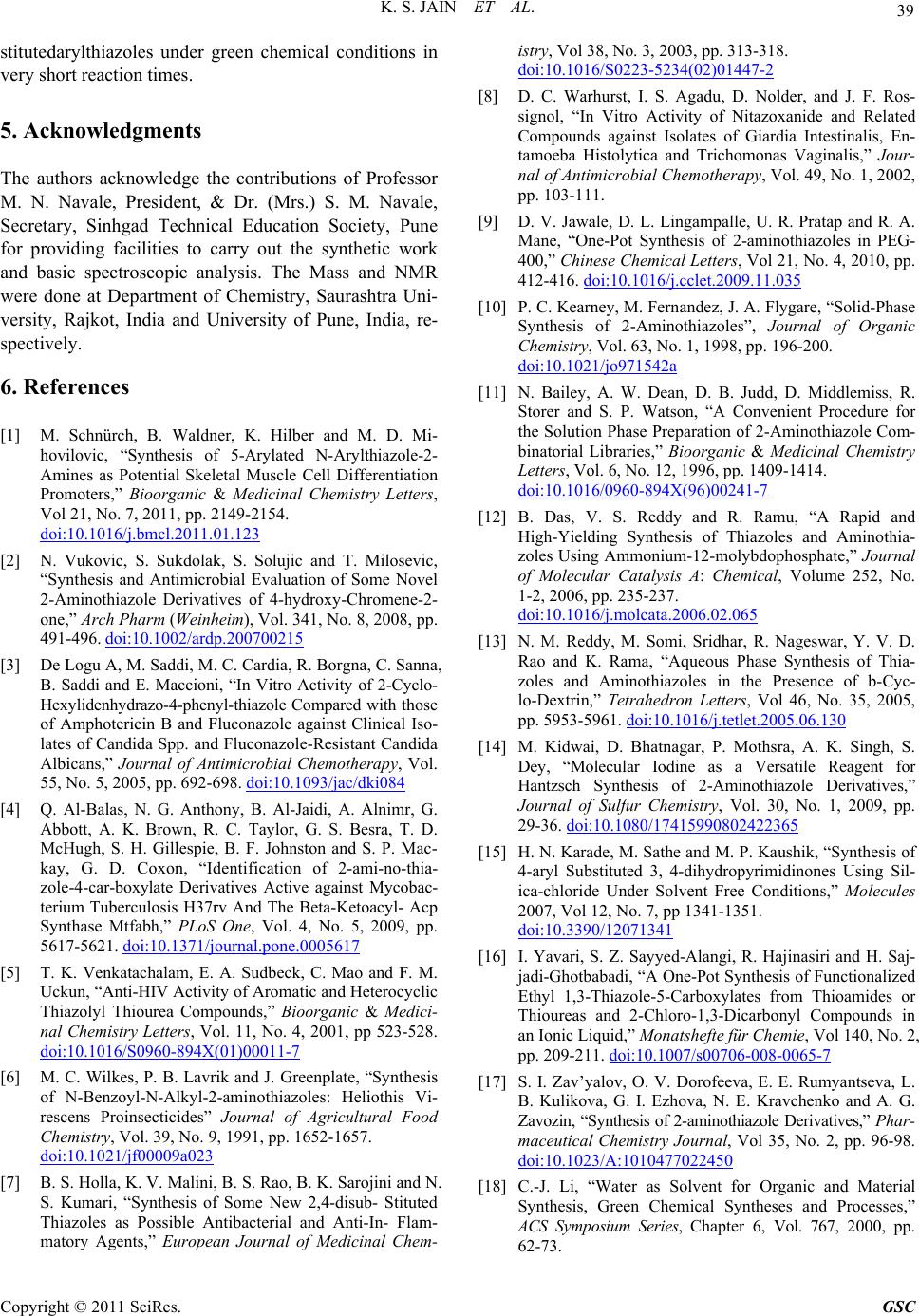
K. S. JAIN ET AL.
Copyright © 2011 SciRes. GSC
39
stitutedarylthiazoles under green chemical conditions in
very short reaction times.
5. Acknowledgments
The authors acknowledge the contributions of Professor
M. N. Navale, President, & Dr. (Mrs.) S. M. Navale,
Secretary, Sinhgad Technical Education Society, Pune
for providing facilities to carry out the synthetic work
and basic spectroscopic analysis. The Mass and NMR
were done at Department of Chemistry, Saurashtra Uni-
versity, Rajkot, India and University of Pune, India, re-
spectively.
6. References
[1] M. Schnürch, B. Waldner, K. Hilber and M. D. Mi-
hovilovic, “Synthesis of 5-Arylated N-Arylthiazole-2-
Amines as Potential Skeletal Muscle Cell Differentiation
Promoters,” Bioorganic & Medicinal Chemistry Letters,
Vol 21, No. 7, 2011, pp. 2149-2154.
doi:10.1016/j.bmcl.2011.01.123
[2] N. Vukovic, S. Sukdolak, S. Solujic and T. Milosevic,
“Synthesis and Antimicrobial Evaluation of Some Novel
2-Aminothiazole Derivatives of 4-hydroxy-Chromene-2-
one,” Arch Pharm (Weinheim), Vol. 341, No. 8, 2008, pp.
491-496. doi:10.1002/ardp.200700215
[3] De Logu A, M. Saddi, M. C. Cardia, R. Borgna, C. Sanna,
B. Saddi and E. Maccioni, “In Vitro Activity of 2-Cyclo-
Hexylidenhydrazo-4-phenyl-thiazole Compared with those
of Amphotericin B and Fluconazole against Clinical Iso-
lates of Candida Spp. and Fluconazole-Resistant Candida
Albicans,” Journal of Antimicrobial Chemotherapy, Vol.
55, No. 5, 2005, pp. 692-698. doi:10.1093/jac/dki084
[4] Q. Al-Balas, N. G. Anthony, B. Al-Jaidi, A. Alnimr, G.
Abbott, A. K. Brown, R. C. Taylor, G. S. Besra, T. D.
McHugh, S. H. Gillespie, B. F. Johnston and S. P. Mac-
kay, G. D. Coxon, “Identification of 2-ami-no-thia-
zole-4-car-boxylate Derivatives Active against Mycobac-
terium Tuberculosis H37rv And The Beta-Ketoacyl- Acp
Synthase Mtfabh,” PLoS One, Vol. 4, No. 5, 2009, pp.
5617-5621. doi:10.1371/journal.pone.0005617
[5] T. K. Venkatachalam, E. A. Sudbeck, C. Mao and F. M.
Uckun, “Anti-HIV Activity of Aromatic and Heterocyclic
Thiazolyl Thiourea Compounds,” Bioorganic & Medici-
nal Chemistry Letters, Vol. 11, No. 4, 2001, pp 523-528.
doi:10.1016/S0960-894X(01)00011-7
[6] M. C. Wilkes, P. B. Lavrik and J. Greenplate, “Synthesis
of N-Benzoyl-N-Alkyl-2-aminothiazoles: Heliothis Vi-
rescens Proinsecticides” Journal of Agricultural Food
Chemistry, Vol. 39, No. 9, 1991, pp. 1652-1657.
doi:10.1021/jf00009a023
[7] B. S. Holla, K. V. Malini, B. S. Rao, B. K. Sarojini and N.
S. Kumari, “Synthesis of Some New 2,4-disub- Stituted
Thiazoles as Possible Antibacterial and Anti-In- Flam-
matory Agents,” European Journal of Medicinal Chem-
istry, Vol 38, No. 3, 2003, pp. 313-318.
doi:10.1016/S0223-5234(02)01447-2
[8] D. C. Warhurst, I. S. Agadu, D. Nolder, and J. F. Ros-
signol, “In Vitro Activity of Nitazoxanide and Related
Compounds against Isolates of Giardia Intestinalis, En-
tamoeba Histolytica and Trichomonas Vaginalis,” Jour-
nal of Antimicrobial Chemotherapy, Vol. 49, No. 1, 2002,
pp. 103-111.
[9] D. V. Jawale, D. L. Lingampalle, U. R. Pratap and R. A.
Mane, “One-Pot Synthesis of 2-aminothiazoles in PEG-
400,” Chinese Chemical Letters, Vol 21, No. 4, 2010, pp.
412-416. doi:10.1016/j.cclet.2009.11.035
[10] P. C. Kearney, M. Fernandez, J. A. Flygare, “Solid-Phase
Synthesis of 2-Aminothiazoles”, Journal of Organic
Chemistry, Vol. 63, No. 1, 1998, pp. 196-200.
doi:10.1021/jo971542a
[11] N. Bailey, A. W. Dean, D. B. Judd, D. Middlemiss, R.
Storer and S. P. Watson, “A Convenient Procedure for
the Solution Phase Preparation of 2-Aminothiazole Com-
binatorial Libraries,” Bioorganic & Medicinal Chemistry
Letters, Vol. 6, No. 12, 1996, pp. 1409-1414.
doi:10.1016/0960-894X(96)00241-7
[12] B. Das, V. S. Reddy and R. Ramu, “A Rapid and
High-Yielding Synthesis of Thiazoles and Aminothia-
zoles Using Ammonium-12-molybdophosphate,” Journal
of Molecular Catalysis A: Chemical, Volume 252, No.
1-2, 2006, pp. 235-237.
doi:10.1016/j.molcata.2006.02.065
[13] N. M. Reddy, M. Somi, Sridhar, R. Nageswar, Y. V. D.
Rao and K. Rama, “Aqueous Phase Synthesis of Thia-
zoles and Aminothiazoles in the Presence of b-Cyc-
lo-Dextrin,” Tetrahedron Letters, Vol 46, No. 35, 2005,
pp. 5953-5961. doi:10.1016/j.tetlet.2005.06.130
[14] M. Kidwai, D. Bhatnagar, P. Mothsra, A. K. Singh, S.
Dey, “Molecular Iodine as a Versatile Reagent for
Hantzsch Synthesis of 2-Aminothiazole Derivatives,”
Journal of Sulfur Chemistry, Vol. 30, No. 1, 2009, pp.
29-36. doi:10.1080/17415990802422365
[15] H. N. Karade, M. Sathe and M. P. Kaushik, “Synthesis of
4-aryl Substituted 3, 4-dihydropyrimidinones Using Sil-
ica-chloride Under Solvent Free Conditions,” Molecules
2007, Vol 12, No. 7, pp 1341-1351.
doi:10.3390/12071341
[16] I. Yavari, S. Z. Sayyed-Alangi, R. Hajinasiri and H. Saj-
jadi-Ghotbabadi, “A One-Pot Synthesis of Functionalized
Ethyl 1,3-Thiazole-5-Carboxylates from Thioamides or
Thioureas and 2-Chloro-1,3-Dicarbonyl Compounds in
an Ionic Liquid,” Monatshefte für Chemie, Vol 140, No. 2,
pp. 209-211. doi:10.1007/s00706-008-0065-7
[17] S. I. Zav’yalov, O. V. Dorofeeva, E. E. Rumyantseva, L.
B. Kulikova, G. I. Ezhova, N. E. Kravchenko and A. G.
Zavozin, “Synthesis of 2-aminothiazole Derivatives,” Phar-
maceutical Chemistry Journal, Vol 35, No. 2, pp. 96-98.
doi:10.1023/A:1010477022450
[18] C.-J. Li, “Water as Solvent for Organic and Material
Synthesis, Green Chemical Syntheses and Processes,”
ACS Symposium Series, Chapter 6, Vol. 767, 2000, pp.
62-73.